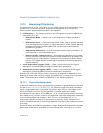
10-46 Vol. 3
ADVANCED PROGRAMMABLE INTERRUPT CONTROLLER (APIC)
10.7.2 Determining IPI Destination
The destination of an IPI can be one, all, or a subset (group) of the processors on the
system bus. The sender of the IPI specifies the destination of an IPI with the
following APIC registers and fields within the registers:
• ICR Register — The following fields in the ICR register are used to specify the
destination of an IPI:
— Destination Mode — Selects one of two destination modes (physical or
logical).
— Destination Field — In physical destination mode, used to specify the APIC
ID of the destination processor; in logical destination mode, used to specify a
message destination address (MDA) that can be used to select specific
processors in clusters.
— Destination Shorthand — A quick method of specifying all processors, all
excluding self, or self as the destination.
— Delivery mode, Lowest Priority — Architecturally specifies that a lowest-
priority arbitration mechanism be used to select a destination processor from
a specified group of processors. The ability of a processor to send a lowest
priority IPI is model specific and should be avoided by BIOS and operating
system software.
• Local destination register (LDR) — Used in conjunction with the logical
destination mode and MDAs to select the destination processors.
• Destination format register (DFR) — Used in conjunction with the logical
destination mode and MDAs to select the destination processors.
How the ICR, LDR, and DFR are used to select an IPI destination depends on the
destination mode used: physical, logical, broadcast/self, or lowest-priority delivery
mode. These destination modes are described in the following sections.
10.7.2.1 Physical Destination Mode
In physical destination mode, the destination processor is specified by its local APIC
ID (see
Section 10.4.6, “Local APIC ID”). For Pentium 4 and Intel Xeon processors,
either a single destination (local APIC IDs 00H through FEH) or a broadcast to all
APICs (the APIC ID is FFH) may be specified in physical destination mode.
A broadcast IPI (bits 28-31 of the MDA are 1's) or I/O subsystem initiated interrupt
with lowest priority delivery mode is not supported in physical destination mode and
must not be configured by software. Also, for any non-broadcast IPI or I/O
subsystem initiated interrupt with lowest priority delivery mode, software must
ensure that APICs defined in the interrupt address are present and enabled to receive
interrupts.
For the P6 family and Pentium processors, a single destination is specified in physical
destination mode with a local APIC ID of 0H through 0EH, allowing up to 15 local


















